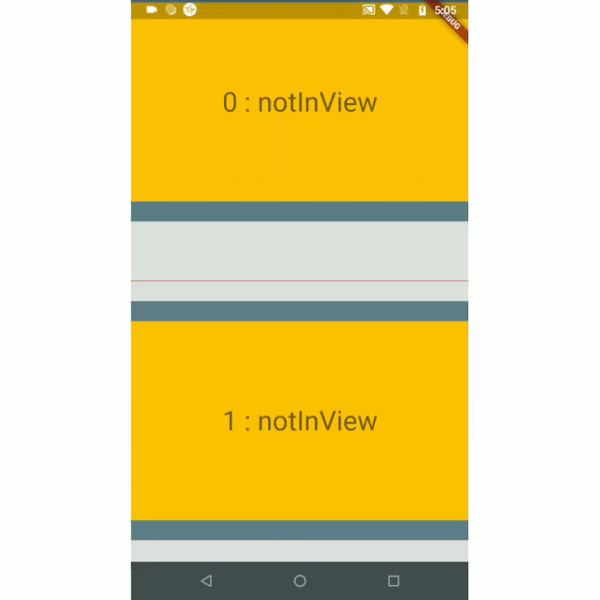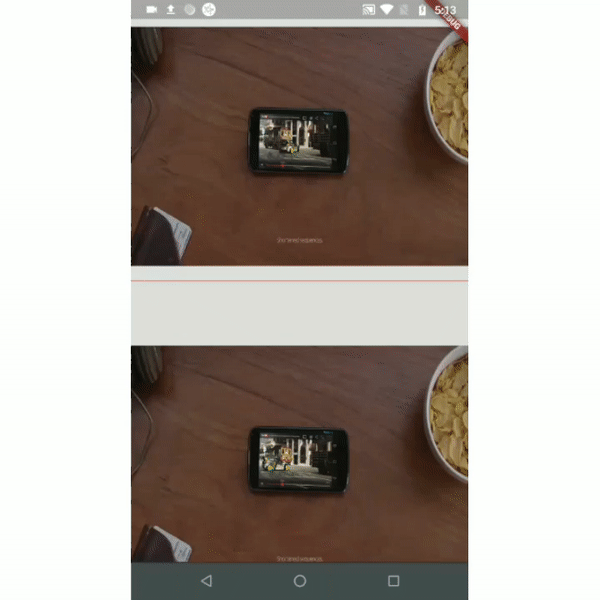A Flutter package that builds a ListView and notifies when the widgets are on screen within a provided area.
| Example 1 | Example 2 | Example 3(Auto-play video) |
|---|---|---|
 |
 |
 |
-
To auto-play a video when a user scrolls.
-
To add real-time update listeners from database to the posts/content only within an area visible to the user.
Note: If you have other use cases please update this section and create aPR.
Just add the package to your dependencies in the pubspec.yaml file:
dependencies:
inview_notifier_list: ^0.0.2Add the InViewNotifierList to your widget tree
import 'package:flutter/material.dart';
import 'package:inview_notifier_list/inview_notifier_list.dart';
class MyApp extends StatelessWidget {
@override
Widget build(BuildContext context) {
return Scaffold(
body: InViewNotifierList(
...
),
);
}
}
Add the required property isInViewPortCondition to the InViewNotifierList widget. This is the function that defines the area which the widgets overlap should be notified as currently in-view.
typedef bool IsInViewPortCondition(
double deltaTop,
double deltaBottom,
double viewPortDimension,
);
It takes 3 parameters:
-
deltaTop: It is the distance from top of the widget to be notified in the list view to top of the viewport(0.0).
-
deltaBottom: It is the distance from bottom of the widget to be notified in the list view to top of the viewport(0.0).
-
viewPortDimension: The height or width of the viewport depending on the
srollDirectionproperty provided. The image below showcases the values if thesrollDirectionisAxis.vertical.
Here is an example that returns true only when the widget's top is above the halfway of the viewport and the widget's bottom is below the halfway of the viewport. It is shown in example1.
InViewNotifierList(
isInViewPortCondition:
(double deltaTop, double deltaBottom, double viewPortDimension) {
return deltaTop < (0.5 * viewPortDimension) &&
deltaBottom > (0.5 * viewPortDimension);
},
),
Add the widgets to be displayed in the list view to the children property.
InViewNotifierList(
isInViewPortCondition:(...){...},
children: <Widget>[
ListChild(...),
ListChild(...),
ListChild(...),
...
],
),Add the widget's context and its String id to the InViewState that you want to be notified whether it is in-view or not.
The InViewState can be accessed by calling the of method of InViewNotifierList anywhere below the InViewNotifierList widget tree as follows:
InViewState state = InViewNotifierList.of(context);Use state to add context for notification.
class ListChild extends StatelessWidget {
final String id;
const ListChild({Key key,@required this.id}) : super(key: key);
@override
Widget build(BuildContext context) {
InViewState state = InViewNotifierList.of(context);
state.addContext(context: context, id: id);
return Container(
...
);
}
}Wrap the widget you want to get notified with an AnimatedBuilder passing the above mentioned InViewState to the animation property.
Then use the InViewState's inView method which takes in the String id as an argument to check if the required widget is currently in-view or not.
Widget build(BuildContext context) {
InViewState state = InViewNotifierList.of(context);
state.addContext(context: context, id: id);
return AnimatedBuilder(
animation: state,
builder: (BuildContext context, Widget child) {
final bool inView = state.inView(id);
return Container(
child: Text(inView ? 'Is in View' : 'Not in View'),
);
},
);
}
You can do the same using an AnimatedWidget.
That's it, done! Run the example app provided and check out the folder for complete code.
isInViewPortCondition: [Required] The function that defines the area within which the widgets should be notified as in-view.children: *The widgets that should be displayed in the list view.initialInViewIds: The String list of unique ids of the child widgets that should be initialized as in-view when the list view is built for the first time.contextCacheCount: The number of widget's contexts theInViewNotifierListshould stored/cached for the calculations thats needed to be done to check if the widgets are in-view or not. Defaults to 10 and should be greater than 1. This is done to reduce the number of calculations being performed.endNotificationOffset: The distance from the bottom of the list where theonListEndReachedshould be invoked. Defaults to the end of the list i.e 0.0.onListEndReached: The function that is invoked when the list scroll reaches the end or theendNotificationOffsetif provided.throttleDuration: The duration to be used for throttling the scroll notification. Defaults to 200 milliseconds.scrollDirection: The axis along which the scroll view scrolls. Defaults toAxis.vertical.controller: An object that can be used to control the position to which this scroll view is scrolled. See ScrollController.
Thanks to Didier Boelens for the raw solution.
